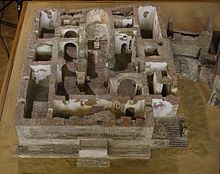Faras Cathedral
The Cathedral of Faras is the most famous Nubian church. The church was excavated in Faras from 1961 to 1964 by a Polish team led by Kazimierz Michałowski . It aroused international interest primarily because of its numerous well-preserved wall paintings. Today these paintings are in the National Museum in Warsaw and in the National Museum of Sudan in Khartoum . The cathedral has disappeared in the waters of Lake Nasser .
The construction history of the cathedral can be divided into three stages, which in turn are related to the activities of important bishops. The oldest building was built in the twenties of the 7th century under the bishop Aetios . It is poorly preserved due to numerous renovations. It was a three-aisled building with an apse . There were columns that divided the church interior into naves and numerous stone decorative elements that were painted in color and represented capitals, lintels and friezes. Only one wall painting has survived from this phase. It is a representation of a chalice with Eucharistic messengers. The building was 24 ½ m × 14 ½ m in size.
In the 11th year of the reign of King Mercurios , this church was expanded in 707 under the Bishop Paulos and enlarged to 24 ½ m × 24 m. This emerges from two foundation deeds written in Greek and Coptic. The lower part of the walls now consisted of stones, which were mostly spoils of pharaonic buildings. The upper part was made of burnt mud bricks. The church received pillars made of granite. Mainly side chapels were built now. This made the interior of the church cruciform. It can be assumed that the church of the granite columns in Old Dunqula served as a model. This building was also richly painted.
At the end of the 10th century this church was rebuilt again. The granite pillars were replaced by brick ones. The wooden roof was replaced by domes. Numerous new wall paintings were added. In the 14th century the bishopric of Faras and Qasr Ibrim was merged. The bishop now resided in Qasr Ibrim. The church fell into disrepair.
literature
- Kazimierz Michalowski : Faras. The cathedral from the desert sand. Recordings by Georg Gerster. Benziger, Einsiedeln et al. 1967.
- Wilfried Seipel : Faras. The cathedral from the desert sand. Skira et al., Milan 2002, ISBN 3-85497-042-0 .
- Włozimierz Godłewski: Pachoras - the cathedrals of Aetios, Paulos and Petros. The architecture (= Polish Archeology in the Mediterranean. Supplement Series. Vol. 1). Warsaw University Press, Warsaw 2006, ISBN 83-235-0167-X .
Web links
- Special exhibition in Vienna on Faras (German and English)
Coordinates: 22 ° 10 ′ 54 ″ N , 31 ° 29 ′ 49 ″ E

